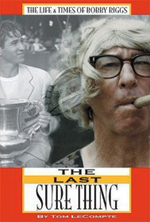The Rise of Jack Kramer and the Fall of Bobby Riggs: Prequel
Tom LeCompte

By 1947, with the amateur game reorganized after World War II, the eyes of the tennis world were on a hot young player named Jack Kramer. One of Perry Jones' "golden boys" from the L.A. Tennis Club, Kramer was tall and handsome. (Click Here for the amazing story of Perry Jones and his unique strangle hold on world tennis.)
Like Budge and Ellsworth Vines, Kramer had a big game, an attacking style that was exciting to watch. Forget Bobby's dominance over him when the two practiced against each other at the L.A. Tennis Club.
Forget that before the war Bobby beat Kramer 9 times out of 10. Once, after having won 27 straight games against Kramer, Bobby told his frustrated younger opponent: "Look, kid. I know you're gonna be a player sometime and we're gonna meet and I just want you to know who's boss."
In 1946, Kramer lost just two matches in the amateur world. He won Forest Hills and anchored the United States team in its dramatic victory over Australia in Melbourne to regain the Davis Cup.
He likely would have won Wimbledon that year had blisters not hampered him on his racquet hand. It seemed clear he would be the star of the next pro tour, which was expected to make a fortune.
Bobby was the reigning professional champion and had established dominance over the previous champion, Don Budge. (Click Here.) By all rights, that tour against Kramer was his.
But the public and the promoter, Jack Harris, had their sights set on a tour that pitted Budge, the Great One, against Kramer, the second coming of Budge. From a commercial standpoint, Budge was so well known, so popular, and had such a terrific record that promoter Harris decided to give Budge a chance by declaring that the winner of the 1947 U. S. Professional Championships at Forest Hills would tour with Kramer.
$100,000 or Nothing
With all the marbles riding on that one tournament, Bobby called it "the $100,000 plum." The winner got the tour and the $100,000. The loser went home with nothing.

On a hot, muggy day on the grass at Forest Hills, the two men met in the final for what turned out to be one of the most important matches of their careers. The tennis, however, failed to live up to the magnitude of the event.
Both players came out tentatively, neither willing to take chances with so much at stake. The result, wrote Bobby, was a display of "mediocre" tennis in which the pair traded the first two sets.
Budge won the first comfortably, 6-3. Bobby took the second, also at 6-3. In the third set, Bobby jumped to a 5-2 lead, and for a moment it seemed that Budge might be ready to fold up and go home. But he dug in, raised his level of play, and broke Bobby's serve to even the set, 5-5.
Serving at 5-6, Budge then saved two set points to knot the match at 6-all. Holding serve to even the set again at 7-7, Budge then broke Bobby's serve to go ahead 8-7, giving him the opportunity to serve out the set.
But then it was Bobby who dug in. He broke Budge's serve to even the set, 8-8, held serve, then broke Budge again to win the set, 10-8. After a 10-minute rest, the players emerged from the locker room after a shower and a change into fresh clothes, Budge jumped to a quick lead and held out to win the fourth set, 6-4.
Everything was now riding on one set. "I thought of all that money and I swore I'd run my legs off before I'd let it get away from me," Bobby later wrote. After two and one-half hours of play, with his arms now cramping, Bobby reached 5-3 in the 5th by using every shot he had--volleys, lobs, drop shots, service aces, groundstroke placements.
Budge fought off three match points. But he followed this with three successive errors, giving Bobby the game, set, and match, 3-6, 6-3, 10-8, 4-6, 6-3. Bobby, not Budge, would tour with Kramer. Years later, Bobby called this his single greatest moment in tennis.

New York in Snow
The first match of the tour was scheduled for the day after Christmas, 1947. New Yorkers, who tend to think of weather as something that only happens to other people, paid little attention to the snow that was falling that morning.
An almost mild 29 degrees, the sky was a conservative shade of gray and there was scarcely a breath of wind. The snowflakes themselves descended in a silent and orderly procession, and not until mid-afternoon did citizens begin to notice how heavily it was falling.
An eerie silence settled over the city. Traffic stopped. Fifth Avenue was white and vacant. Side streets were choked with thousands of stalled cars, busses, and trucks. Parkways were dotted with white mounds, each marking an abandoned automobile.
The heaviest snowfall in 76 years had buried the city. In just over 18 hours, 26 inches had fallen. Central Manhattan subway stations were jammed with pushing, flailing throngs.
At Grand Central Terminal and Pennsylvania Station, crowds stormed train gates requiring police to restore order. The thousands who fought their way into commuter cars soon regretted their triumph, as the trains got stuck soon after leaving the city. Hotels were besieged, and a sea of the stranded headed for bars, all-night movies, and the apartments of friends.
From his room at the Hotel Lexington, promoter Jack Harris stared out into the bleakness. The "Duel of the Decade" was about to become the "Bust in the Blizzard."
For weeks, the press had hyped the series between Jack Kramer and Bobby Riggs as the biggest attraction since pre-war days. More than 16,000 tickets had already been sold.

But the streets were impassable by car. From their hotel just a few blocks away, the players hiked to the arena, literally climbing over snowbanks with racquets in hand.
Across the East River in Queens, John Frankenheimer, a young college student home for the holidays, tried to get through by telephone to the Garden to see if the match had been cancelled or rescheduled, but the lines were jammed.
A star on the Williams College tennis team in Massachusetts, Frankenheimer followed the game like other kids followed baseball. Frankenheimer, who went on to fame as a film director of Hollywood thrillers such as The Manchurian Candidate and Seven Days in May, idolized Kramer and expected to see him demolish Bobby.
Blizzard or no blizzard, he was not about to miss it. He put on his winter coat and a heavy pair of boots, and grabbed a pair of cheap wooden skis. "I took the subway, got off at like 48th and 8th, and I skied for about six blocks."
Frankenheimer wasn't the only one with that idea. Arriving, he was amazed to find that more than 15,000 other fans had also hiked, skied, and even snow shoed their way to Madison Square Garden.
Of 16,052 tickets sold, only 938 people failed to show up. Columnist Jimmy Powers of the New York Post called it "the greatest tribute to an indoor athletic event in the history of sport." The $55,730 in gross receipts was second only to $58,120 taken in at the opening of the Ellsworth Vines and Fred Perry tour in 1937.
Invincible

For two years, "Big Jake," as players and fans called Kramer, had been nearly invincible. He lost just one match in 1947, ending his amateur career on a 41-match win-streak.
He played the kind of game—serve and volley tennis--that was popular with fans. He was also tall, blond, and handsome, with the easygoing manner and healthy glow that was associated with Southern California. Here at last was a hero the nation could get behind.
All that was left was for him to take the crown from Bobby. But it didn't happen the night of the great blizzard.
Most experts figured Kramer's "big game" simply packed too big a punch for Bobby, a player many still considered a scrappy baseliner. But Bobby had a couple of advantages going into Madison Square Garden that night.
One was experience. The lights, the pressure, the crowds all were familiar to him. Another advantage was the element of surprise. He and Kramer had not played against each other in years, and although he was fairly certain how Kramer would play, he was counting on Kramer figuring him strictly as a baseliner, a backcourt player reluctant to come to the net.
Bobby had been planning this match for weeks, approaching it as if it were a chess match. When the house lights dimmed, a weak smattering of applause greeted Bobby as he breezed onto the court with his usual grin and cocksure walk.
The crowd roared when Kramer stepped onto the court. Well aware of the reception he'd receive, Bobby had spent the previous hour working the crowd, cajoling fans into betting $10, $15, $100, and giving odds. Up to the time that play started, he was still negotiating courtside.
The Match
While the fans settled in their seats, Kramer promptly dropped the first three games. In 20 minutes, Bobby had won the first set, 6-2. In a surprising role reversal, Bobby was the aggressor and Kramer the counter puncher.

"Kramer had a faulty backhand and so, unless I had an open court, every shot would go to his backhand. Not most of them, all of them," Bobby explained. At times, Kramer had to stoop to his shoetops to scrape Bobby's heavily sliced shots as they skidded off the court.
Kramer showed flashes of brilliance. In the second set, at 4-all, he had Bobby down 15-40 on his serve. But Bobby wriggled out of that and won the set, 10-8. After winning the third set, 6-4, Kramer went up a break in the fourth, but Bobby broke back twice to take the set and match, 6-2, 10-8, 4-6, 6-4.
For every spectacular shot off Kramer's racquet that drew cheers from the audience, there were twice as many misses. He over hit. He missed approach shots and could not pass Bobby at the net. Even his feared serve failed him when he needed it most, as he double faulted on crucial points.
Afterwards, Kramer admitted he had been nervous, and said he had trouble adjusting to the indoor conditions and the canvas court. "But that's no alibi," he said. "I got jittery and missed the easy ones." It was a great start to the tour for Bobby, but the future would bring a very, very different outcome.





